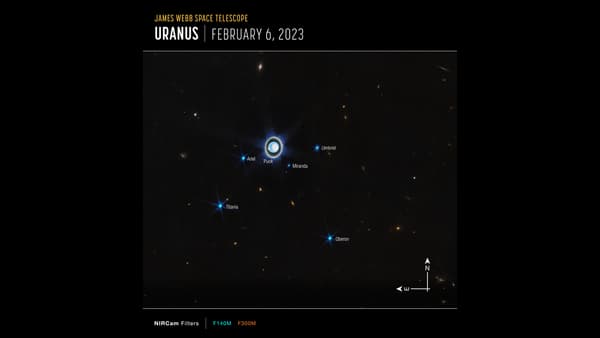A single shot. NASA has released new images captured by the James Webb Space Telescope, including several of Uranus, the seventh planet in the solar system in order of distance from the Sun and the third largest.
Located more than 2,500 million kilometers from Earth, until then it had only been immortalized by the Voyager 2 probe in 1986 and by the Keck observatory, located on the island of Hawaii. The recent images, taken on February 6, reveal many more details of this still little-known planet.
“With infrared wavelengths and Webb’s increased sensitivity, we see more detail, showing just how dynamic Uranus’ atmosphere is,” NASA wrote on its site.
eleven rings
In the images we see the ice giant surrounded by eleven of its thirteen rings. With James-Webb sensitivity, some of them are so bright that when they are close together they seem to merge into a larger ring.
Nine of these rings are considered to be the planet’s main rings, and two are less luminous dusty rings, which were not discovered until after Voyager 2’s flyby in 1986.
90 degree rotation
The peculiarity of Uranus is its rotation: it turns sideways, at an angle of about 90 degrees with respect to the plane of its orbit. In addition, it takes 84 years to go around the Sun. The seasons on this planet are therefore extreme.
Consequently, as the European Space Agency reminds us, certain parts of a hemisphere are deprived of sunlight for periods of up to 42 years. “This causes extreme seasons, as the planet’s poles experience many years of constant sunshine followed by an equal number of years of total darkness,” the ESA said.
On the right side of the planet, there is also an area of brightness at the Sun-facing pole, known as the polar cap. It is unique to Uranus in that it appears to appear when the pole is exposed to direct sunlight in the summer and disappears in the fall.
“The data provided by Webb will help scientists understand this mechanism for mysterious weather,” NASA details.

Six of the 27 known moons
At the edge of this polar cap, we can see a bright cloud and a second one at the left edge of the planet. “These clouds are typical of Uranus in the infrared wavelengths and are probably related to thunderstorm activity,” Esa says.
The James Webb Telescope also captured six of Uranus’s 27 known moons, most of which are too small and faint to be seen in these images.
In 2022, American scientific institutions identified Uranus as a priority in their studies for the next decade, NASA explains, adding that various works are already underway to understand the mysteries of this planet.
Source: BFM TV

